12 December, 2003
Remote Gas Sampling
While I have accompanied Shauna Mikelich up to the crater rim to pump
gas directly from Mt. Erebus’s plume (see 12/08/03 The Pump
Station), Dr. Clive Oppenheimer and Dawn Sweeney have been using
remote sensing to measure the gas emissions from Mount Erebus. An older
method, that we are still using this year, employs a COSPEC (Correlation
Spectrometer). In this process, a large spectrometer is housed in the
Lower Erebus Hut garage (Figures 1 and 2). On days when the plume is
rising straight up in the sky, the COSPEC is aimed at the plume and can
sample how much sulfur dioxide (SO2) is emitted from Erebus.
Determination of gas concentration is based on the degree of absorption
of UV radiation by SO2 parcticles in the plume (Figure 3). The new method
employed this season is called DOAS (Differential Optical Absorption
Spectrometry). This method is similar to COSPEC in that it also measures
the amount of UV radiation transmitted though the plume in order to
establish gas concentration. DOAS, however, is capable of measuring all
of the gases emitted in a volcanic plume (sulfur dioxide, carbon
dioxide, water vapor, etc) and weighs a fraction of the big, bulky
COSPEC allowing for a greater range of remote sensing (Figures 4-8).
Gas emissions are important for understanding the internal plumbing of
the volcano, the rate of magma recharge, and the potential volcanic
activity and human health hazards. The major volcanic gasses (H2O, CO2,
SO2, HCl and HF) are soluble (dissolved into the magma) at different
pressures and temperatures. By determining the volume of each gas
released in the plume, you can determine the maximum depth of the magma
source (the closer to the surface of the Earth, the lower the pressure
and therefore more of any given gas will be released). In the case of
Mt. Pinatubo in the Philippines, the volume of SO2 released from the
volcano increased dramatically leading up to the eruption as magma
migrated up the volcanic conduit. Understanding what the baseline
volumes are for volcanoes like Erebus, and how the volumes change as
activity increases, may help in predicting eruptions. With Erebus, there
is a continuously convecting lava lake, which means that gasses are
released at the surface, but then recharged again at depth. Changes in
the baseline levels of volcanic gasses may help to determine the
convection rate. Finally, SO2, HCl, HF gasses pose a health hazard for
humans and livestock and can affect agriculture.
Helping Dawn tote around her computer, DOAS, GPS, and battery backpack
on foot gave me a great appreciation for the new, “lighter” system… and
for Skidoos. I wouldn’t want to carry around the 85-pound COSPEC! As we
scurried out of the way of an incoming helicopter, the backpack felt a
lot heavier than the 20-pound battery that was in it. Dropping our load
in the hut, we wandered out to watch one of the large 212 helicopters
sling a broken Skidoo back to McMurdo. Frosted from head to toe with
snow from the propeller wash, it was time to call it quits for the day
and warm up in the hut.

1. Figure 1 – Dawn Sweeney monitors the COSPEC (Correlation Spectrometer) gas-sampling machine. This device allows for remote sensing of the amount of SO2 in the plume of the volcano. Stationed in the Lower Erebus Hut garage, researchers can work in relative warmth while monitoring the volcano.

2. Figure 2 – The COSPEC has been in use for monitoring SO2 emissions since 1983. The large box monitors SO2 gas emissions by recording how much UV light comes through the plume while the video camera records the motion of the plume and provides a time correlation for the plume speed and COSPEC record.
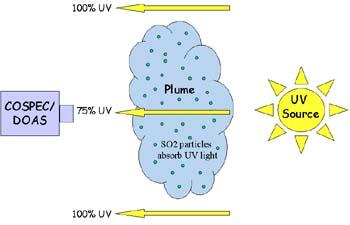
3. Figure 3 – Diagram illustrating how the COSPEC and DOAS work. If you have a known energy source (microwave, IR, visible light, UV), you can measure how much of that energy is transmitted through the plume. In this case, there is enough SO2 gas in the plume to absorb some of the UV energy. The more molecules there are to interact with the energy source, the less energy is transmitted to the COSPEC or DOAS. A known correlation exists for the amount of energy transmitted through a given thickness of plume and the number of gas molecules.
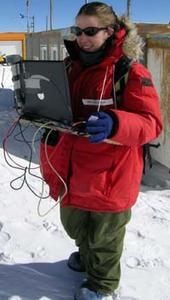
4. Figure 4 – Dawn also monitors gas emissions by walking traverses underneath the plume. Fieldwork requires innovation. Dawn has built a sling to carry her laptop with her in the field. Strapped to the top left corner of her computer is a DOAS (Differential Optical Absorption Spectroscopy) sensor, which measures gasses emitted in the plume. Cords running from her computer connect the sensor and a GPS unit (tucked in her sleeve pocket), which tracks her position and the time.
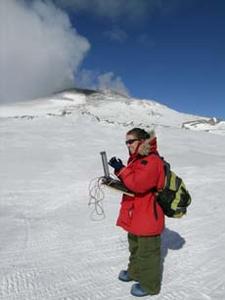
5. Figure 5 – Dawn’s sampling get-up is bulky and heavy. In order to keep her laptop from losing power in the cold, she carries a 20 pound 12 V battery in her backpack. Erebus is emitting a nice plume in the background.

6. Figure 6 – An easier way to conduct traverses is by Skidoo. Clive Oppenheimer, from Cambridge, straps his laptop and COSPEC sensor to the back of a Skidoo and can quickly traverse back and forth beneath the plume.
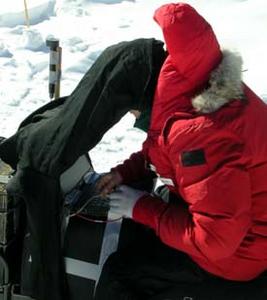
7. Figure 7 – Again, adapting a laptop to use in the field is not always easy. Bright light makes the screen difficult to see, so a jacket over the head makes a good dark room. Duct tape secures the DOAS sensor to a bamboo pole to keep it pointed at the plume for monitoring.

8. Figure 8 – Who needs a "ToughBook"? Clive has “ruggedized” his laptop for fieldwork by duct taping bubble wrap to the outside. Again, duct tape holds the DOAS sensor to a camera tripod in the background.
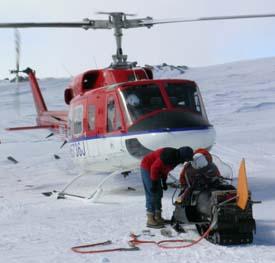
9. Figure 9 – Unfortunately, not everything broken at Erebus can be fixed in the field. One of our two-man Scandic Skidoos sheared a bolt and lost steering. The Skidoo is being returned to McMurdo for repair, further limiting our transportation capabilities for the season. Phil Kyle helps Ryan, a helitech, strap the skidoo for slinging and attach a fin.
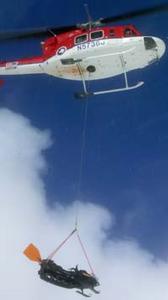
10. Figure 10 – Our Skidoo is slung below the helicopter back to McMurdo for repair. A fin attached to the back keeps the snowmobile from spinning on its cable as it is transported. A large 212 helicopter handles this load.
Contact the TEA in the field at
.
If you cannot connect through your browser, copy the
TEA's e-mail address in the "To:" line of
your favorite e-mail package.
|
